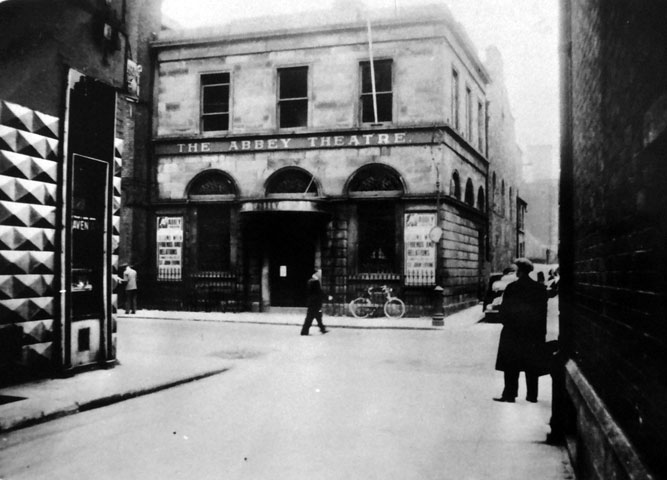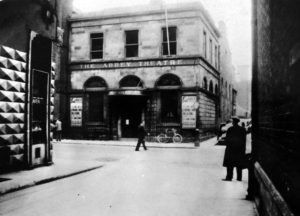As with any political movement, the ideals of Irish Nationalism materialized on the stage of the Abbey Theatre on Lower Abbey Street in central Dublin. Although it was envisioned as a machination of the Irish Literary Revival, it becomes the theater that featured the performances that shaped and amplified the politics of nationalist Dubliners and the site of many audience riots.
The Theatre had originated as a project undertaken by W.B. Yeats, Lady Augusta Gregory, Edward Martyn, the brothers Frank and William Fay, and Englishwoman Annie Horniman. While the Fay brothers provided their skills as directors, Horniman provided funds helped to imbue a sense of decadence into the interior.

Horniman’s influence, in the words of critic Adrian Frazier, would “make the rich feel at home, and the poor—on a first visit—out of place.”
The general nature of the Theater’s reputation is damaged early on when playwright John Millington Synge’s The Playboy of the Western World causes an intense riot in the audience. The “Playboy Riots” were the first of a number of nationalist-inspired disturbances triggered by the impartiality found in the dramatists featured at the Theater. Even Sean O’Casey’s integral piece The Plough and the Stars the third and final part of the Dublin Trilogy, caused a riot as well for its political punctuation or lack thereof.
Maud Gonne, did not participate in the Easter Rising like her then-husband John MacBride did, however her influence on the Theatre
The Theatre famously employed poignant figures in the Rising, many of whom did take up arms including Constance Markievicz, and Sean Connolly.
Other members of the Abbey ensemble who fought in the rising included Helena Molony, and Arthur Shields. This era of the Theatre until well after the rising features more sympathetic or pro-Irish performances than those of its early phase.

Helena Molony was an actor at the Abbey Theatre from 1912-1927 and had roles in 102 productions. She dedicated much of her life to Irish Nationalism, evidenced in part by her prominence within “Cumann na mBan” (The Irishwomen’s Council). Inspired by a 1903 speech from Maud Gonne, she aided the movement through labor activism and her successes in convincing Dr. Kathleen Lynn and Countess Markievicz to adopt nationalism. When she took up arms during the rising she witnessed the death of her commander the then-Captain Sean Connolly on the roof of Dublin’s City Hall.

Shields was a long-standing member of the Abbey Theatre beginning in 1914, and continuing to 1939 when he departed to work with filmmakers in the U.S. During his tenure, Shields acted in around 300 productions and took on the duties of the assistant director, director, and the stage manager for many of the Theatre’s seasons. After fighting in the rising he was captured and was held for six months at the Welsh Frongoch internment camp. Upon his release he returned to the Abbey’s stage.
Sources
Boylan, Henry (1999). A Dictionary of Irish Biography. Dublin: Gill and Macmillan. ISBN 0-7171-2945-4.
“The Abbey Theatre Archive” –http://www.abbeytheatre.ie/archives/person_detail/13635


